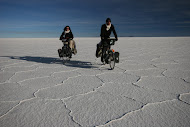New Year's Eve, at the foot of Cerro Torre in the Fitz Roy massif. The tent is set up but we have not enjoyed our festive meal. The lights of the sunset inflame the peaks surrounding us, and we decide to go watching the sunset from the banks of Lago Torre. We leave the camp and we cross a field of boulders, some of which reach several meters. To access the lake view, we need to climb on top of a hill. Up there, the show is unbelievable. Cerro Torre shines on the sunset light and reflects on the waters of the lake.

But we are intrigued by the shape of the hill on which we stand: it forms a long tapered peak that is surrounding the lake. In addition, the hill is not an outcrop, but a pile of boulders of varying types and sizes. By observing these blocks closer, most bear traces of scratches, like the block that we observed in the middle of the Argentine pampas. All these blocks have been transported by the glacier Agostini that runs on the slopes of Cerro Torre and feeds the waters of Lago Torre. This accumulation of blocks is called a glacial moraine.

How to form a glacial moraine? To find out, we must understand how a glacier works. A glacier is fed continuously by snow on top of high mountains. At high altitude, the snow never melts and accumulates every year. By accumulating, the snow turns into ice and then"flows" slowly under its own weight. The motion of the glacier scratches boulders from the sides of the mountains and transport them downstream. When the glacier reaches lower altitudes, the ice melts in front of the tongue ice and the boulders contained in the ice are released just at the ice front. As this phenomenon occurs continuously, many boulders are released around the front of the tongue to form a glacial moraine. When glaciers retreat due to climate change, the moraines are isolated and form of ridge. Moraine ridges therefore mark the location and form of the ancient glaciers fronts. In the case of Lago Torre, the morainic ridge forms a natural dam and keeps the waters of the lake.

Before arriving at Lago Torre, the trail passes through several successive moraine ridges. Each ridge marks the location of the front of the Agostini glacier at a given time. While the Moraine of Lake Torre is empty of vegetation, others are more or less settled by the forest. These later are thus older. By studying the relative ages between all these moraine ridges, it is possible to reconstruct the various stages of evolution of the Agostini glacier. This type of work can be performed on any glacier, including those that no longer exist. Thus, geologists and glaciologists have been able to reconstruct the extent of the glaciers during the last period of glaciations.


